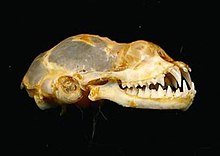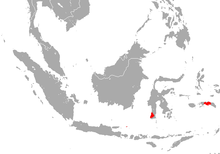
The Indian roundleaf bat, also known as the large Ceylon leaf-nosed bat or Kelaart's leaf‐nosed bat is a species of bat in the family Hipposideridae. It is endemic to the Indian subcontinent, with marginal populations also detected in Southeast Asia. Its natural habitats are subtropical or tropical dry forests and caves. The bat has three subspecies that occur in India, Sri Lanka, and Myanmar. The Indian subspecies, H. l. indus, is smaller than the ones found in Sri Lanka and Myanmar, although there are no other characteristics that differentiate the subspecies.

The bicolored roundleaf bat is a species of bat in the family Hipposideridae found in Indonesia, Malaysia, the Philippines, Thailand, and Timor-Leste. This bat inhabits caves, rock crevices and tunnels among lowland forests. They roost in large numbers and consume mostly small winged insects. Their navigation and hunting skills come from the use of echolocation. Its leafnose is used to release ultrasonic shouts to distinguish its surroundings. Echolocation is also used to distinguish other species based on their wingbeat and size. The habitat of this bat decides the color of its fur. Bleaching fumes of a cave environment will cause an orange colored fur. Those who inhabit a well-ventilated roost will be a light brown color.

Sundevall's roundleaf bat, also called Sundevall's leaf-nosed bat, is a species of bat in the family Hipposideridae.

The short-tailed roundleaf bat is a species of bat in the family Hipposideridae. It is found in Cameroon and Equatorial Guinea. Its natural habitats are subtropical or tropical moist lowland forests and caves. It is threatened by habitat loss.

The Makira roundleaf bat is a species of bat in the family Hipposideridae endemic to the Solomon Islands.

The Kolar leaf-nosed bat, or leafletted leaf-nosed bat is a species of bat in the family Hipposideridae. It is endemic to India. Its natural habitats are subtropical or tropical dry forests and caves. It is found in only one cave in India, and its population is less than 200 individuals.

The crested roundleaf bat is a species of bat in the family Hipposideridae. It is endemic to Indonesia.

The Maggie Taylor's roundleaf bat is a species of bat in the family Hipposideridae. It is found in West Papua (Indonesia) and Papua New Guinea.
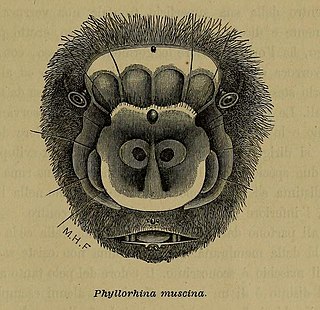
The Fly River roundleaf bat is a species of bat in the family Hipposideridae. It is found in West Papua, Indonesia and Papua New Guinea.

The Biak roundleaf bat or Geelvinck Bay leaf-nosed bat is a species of bat in the family Hipposideridae. It is endemic to the Biak Islands and Cenderawasih Bay area of Papua Province, located in Western New Guinea, Indonesia.
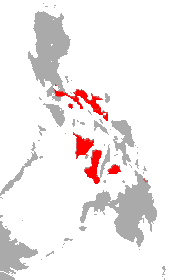
The Philippine pygmy roundleaf bat, also called the Philippine pygmy leaf-nosed bat, is a species of bat in the family Hipposideridae. It is endemic to the Philippines, where it has been recorded on Bohol, Luzon, Marinduque, Negros, Panay, and Mindanao.

Schneider's leaf-nosed bat or Schneider's roundleaf bat is a species of bat in the family Hipposideridae. It is endemic to South Asia. Its natural habitats are subtropical or tropical dry forests, caves, and urban areas.

The Sumba roundleaf bat is a species of bat in the family Hipposideridae. It lives in Indonesia and East Timor. It is present on the islands of Sumba, Rote, Sumbawa, Flores, Semau, and Savu.

Lamotte's roundleaf bat is a species of bat found only at Mount Nimba on the border of Côte d'Ivoire, Guinea and Liberia. It is critically endangered.
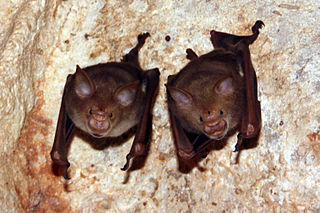
The Hipposideridae are a family of bats commonly known as the Old World leaf-nosed bats. While it has often been seen as a subfamily, Hipposiderinae, of the family Rhinolophidae, it is now more generally classified as its own family. Nevertheless, it is most closely related to Rhinolophidae within the suborder Yinpterochiroptera.

The grand roundleaf bat, also known as the grand leaf-nosed bat, is a species of bat in the genus Hipposideros. It can be found in China, Myanmar, Thailand, and Vietnam.
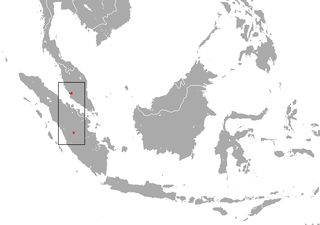
The orbiculus leaf-nosed bat, also known as the orbiculus roundleaf bat and small disc roundleaf bat, is a species of bat from the family Hipposideridae. The species has been found on the island of Sumatra in Indonesia and on peninsular Malaysia.

The Phou Khao Khouay leaf-nosed bat is a species of bat found in Laos and Vietnam. It was described as a new species in 2006. It is considered vulnerable to extinction by the IUCN.
Boeadi’s roundleaf bat is a species of roundleaf bat found in Indonesia.

Hipposideros atrox, commonly known as the lesser bicolored leaf-nosed bat, is a species of bat found in Southeast Asia. Originally described as a subspecies in 1918, it was recognized as a full species in 2010. It uses echolocation to navigate and find prey, and roosts in caves during the day.
